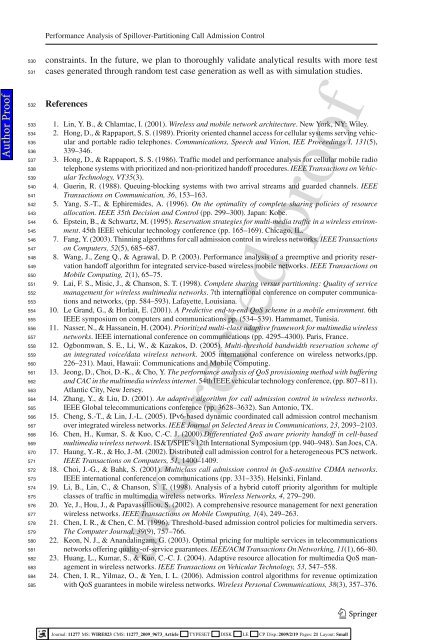Dear Author, Here are the proofs of your article. ⢠You can submit ...
Dear Author, Here are the proofs of your article. ⢠You can submit ...
Dear Author, Here are the proofs of your article. ⢠You can submit ...
- No tags were found...
You also want an ePaper? Increase the reach of your titles
YUMPU automatically turns print PDFs into web optimized ePapers that Google loves.
Performance Analysis <strong>of</strong> Spillover-Partitioning Call Admission Control<strong>Author</strong> Pro<strong>of</strong>530531532533534535536537538539540541542543544545546547548549550551552553554555556557558559560561562563564565566567568569570571572573574575576577578579580581582583584585constraints. In <strong>the</strong> future, we plan to thoroughly validate analytical results with more testcases generated through random test case generation as well as with simulation studies.References1. Lin, Y. B., & Chlamtac, I. (2001). Wireless and mobile network architecture. New York, NY: Wiley.2. Hong, D., & Rappaport, S. S. (1989). Priority oriented channel access for cellular systems serving vehicularand portable radio telephones. Communications, Speech and Vision, IEE Proceedings I, 131(5),339–346.3. Hong, D., & Rappaport, S. S. (1986). Traffic model and performance analysis for cellular mobile radiotelephone systems with prioritized and non-prioritized hand<strong>of</strong>f procedures. IEEE Transactions on VehicularTechnology, VT35(3).4. Guerin, R. (1988). Queuing-blocking systems with two arrival streams and guarded channels. IEEETransactions on Communication, 36, 153–163.5. Yang, S.-T., & Ephiremides, A. (1996). On <strong>the</strong> optimality <strong>of</strong> complete sharing policies <strong>of</strong> resourceallocation. IEEE 35th Decision and Control (pp. 299–300). Japan: Kobe.6. Epstein, B., & Schwartz, M. (1995). Reservation strategies for multi-media traffic in a wireless environment.45th IEEE vehicular technology conference (pp. 165–169). Chicago, IL.7. Fang, Y. (2003). Thinning algorithms for call admission control in wireless networks. IEEE Transactionson Computers, 52(5), 685–687.8. Wang, J., Zeng Q., & Agrawal, D. P. (2003). Performance analysis <strong>of</strong> a preemptive and priority reservationhand<strong>of</strong>f algorithm for integrated service-based wireless mobile networks. IEEE Transactions onMobile Computing, 2(1), 65–75.9. Lai, F. S., Misic, J., & Chanson, S. T. (1998). Complete sharing versus partitioning: Quality <strong>of</strong> servicemanagement for wireless multimedia networks. 7th international conference on computer communicationsand networks, (pp. 584–593). Lafayette, Louisiana.10. Le Grand, G., & Horlait, E. (2001). A Predictive end-to-end QoS scheme in a mobile environment. 6thIEEE symposium on computers and communications pp. (534–539). Hammamet, Tunisia.11. Nasser, N., & Hassanein, H. (2004). Prioritized multi-class adaptive framework for multimedia wirelessnetworks. IEEE international conference on communications (pp. 4295–4300). Paris, France.12. Ogbonmwan, S. E., Li, W., & Kazakos, D. (2005). Multi-threshold bandwidth reservation scheme <strong>of</strong>an integrated voice/data wireless network. 2005 international conference on wireless networks,(pp.226–231). Maui, Hawaii: Communications and Mobile Computing.13. Jeong, D., Choi, D.-K., & Cho, Y. The performance analysis <strong>of</strong> QoS provisioning method with bufferingand CAC in <strong>the</strong> multimedia wireless internet. 54th IEEE vehicular technology conference, (pp. 807–811).Atlantic City, New Jersey.14. Zhang, Y., & Liu, D. (2001). An adaptive algorithm for call admission control in wireless networks.IEEE Global telecommunications conference (pp. 3628–3632). San Antonio, TX.15. Cheng, S.-T., & Lin, J.-L. (2005). IPv6-based dynamic coordinated call admission control mechanismover integrated wireless networks. IEEE Journal on Selected Areas in Communications, 23, 2093–2103.16. Chen, H., Kumar, S. & Kuo, C.-C. J. (2000).Differentiated QoS aw<strong>are</strong> priority hand<strong>of</strong>f in cell-basedmultimedia wireless network. IS&T/SPIE’s 12th International Symposium (pp. 940–948). San Joes, CA.17. Haung, Y.-R., & Ho, J.-M. (2002). Distributed call admission control for a heterogeneous PCS network.IEEE Transactions on Computers, 51, 1400–1409.18. Choi, J.-G., & Bahk, S. (2001). Multiclass call admission control in QoS-sensitive CDMA networks.IEEE international conference on communications (pp. 331–335). Helsinki, Finland.19. Li, B., Lin, C., & Chanson, S. T. (1998). Analysis <strong>of</strong> a hybrid cut<strong>of</strong>f priority algorithm for multipleclasses <strong>of</strong> traffic in multimedia wireless networks. Wireless Networks, 4, 279–290.20. Ye, J., Hou, J., & Papavassilliou, S. (2002). A comprehensive resource management for next generationwireless networks. IEEE Transactions on Mobile Computing, 1(4), 249–263.21. Chen, I. R., & Chen, C. M. (1996). Threshold-based admission control policies for multimedia servers.The Computer Journal, 39(9), 757–766.22. Keon, N. J., & Anandalingam, G. (2003). Optimal pricing for multiple services in telecommunicationsnetworks <strong>of</strong>fering quality-<strong>of</strong>-service guarantees. IEEE/ACM Transactions On Networking, 11(1), 66–80.23. Huang, L., Kumar, S., & Kuo, C.-C. J. (2004). Adaptive resource allocation for multimedia QoS managementin wireless networks. IEEE Transactions on Vehicular Technology, 53, 547–558.24. Chen, I. R., Yilmaz, O., & Yen, I. L. (2006). Admission control algorithms for revenue optimizationwith QoS guarantees in mobile wireless networks. Wireless Personal Communications, 38(3), 357–376.uncorrected pro<strong>of</strong>123Journal: 11277 MS: WIRE823 CMS: 11277_2009_9673_Article TYPESET DISK LE CP Disp.:2009/2/19 Pages: 21 Layout: Small
















